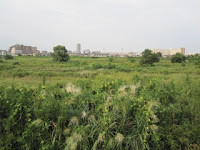
I took the 2nd part of Sumida River Walk. It was from Asakusa (7-8 km from the river mouth) to Senju (14-15 km from the mouth).
Asahi Brewery’s headquarters stands at the riverside at Asakusa. The design is impressive and controversial. The riverside is always crowded with shoppers, tourists and the passengers of waterbuses.
The northern part of Taito Ward, north of Asakusa, used to be a district where many chiep rooming houses stood and thousands of day labors kived. The district was called
Sanya. The Sumida River was the east border of Sanya district.
The district has been redeveloped after the 1970s. Many modern apartment houses have been built and small rooming houses have been converted into clean traveller's inns (sometimes for foreign tourists). Still, there remain old buildings.
The riverside is generally clean. People were enjoying walking and fishing. However, I saw blue plastic houses, too. The water flew slowly.
The Sumida River makes a big turn at Minami-Senju, Arakawa Ward.
The part was developed as an industrial area in the early 20th century. It has turned to a modern residential area after the 1970s. The riverside has become a beautiful park.
Famous
Haiki poet
Matsu Basho took off a boat and started his walking travel at Senju to Tohoku district in 1689. He travelled Tohoku, Hokuriku, and Kansai districts and died in Ogaki, Gifu Prefecture dring the travel. The essay of the travel is known as "Oku-no-Hosomichi", one of the masterpieces of Japanese literature. A picture of the departure scene is drawn on the riverside wall near Senju-Ohashi Bridge.



















































